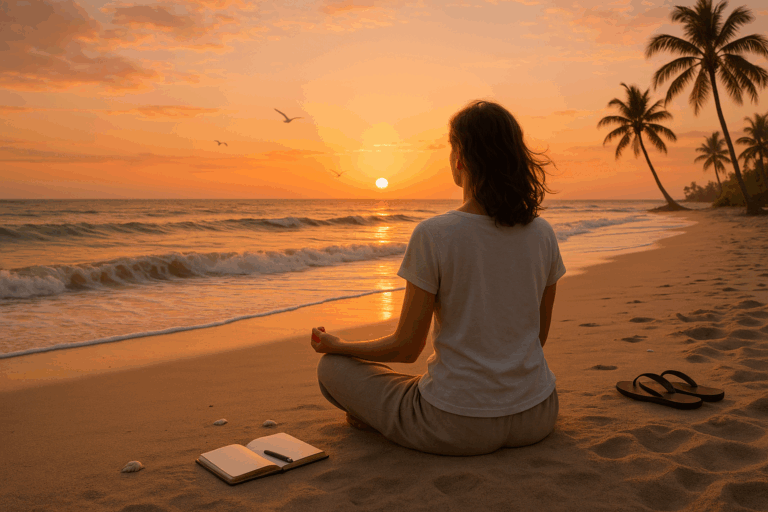The rustle of leaves, the chirping of birds, the soothing tones of a nearby stream, all seem to be nature’s way of reaching out and rewinding our frayed nerves. But what if you could tap into this restorative power on a deeper, more conscious level? The concept of spending three silent days in nature as a form of mental detox is an invitation to do exactly that.
Imagine three days without distractions, without the incessant beeping of your phone, without the need to check your emails, social media, or news. Imagine having the luxury of time to focus on your inner world, your thoughts, your feelings, and your connection with nature. This is what a mental detox is all about.
This article is a comprehensive guide to understanding the concept of a mental detox and how to successfully embark on this journey. We will explore the benefits of silence and solitude, the transformative power of nature, and provide a step-by-step guide on how to plan and prepare for your mental detox.
Modern life can be a whirlwind of responsibilities and commitments, leading to stress, anxiety, and burnout. Our minds are constantly processing information, making decisions, and juggling tasks. This constant mental activity can deplete our mental energy and leave us feeling drained and exhausted. A mental detox, much like a physical detox, is a way to cleanse our minds, recharge our mental energy, and restore our focus and clarity.
A mental detox can be a powerful tool for self-discovery and personal growth. It is a chance to gain insights into our thoughts and emotions, identify patterns, and find new ways of thinking and responding. Through this process, we can develop greater self-awareness, improve our emotional health, and enhance our ability to manage stress and cope with life’s challenges.
Spending three silent days in nature offers a unique setting for a mental detox. Nature has a calming and healing effect on our minds. The sights, sounds, and smells of nature can lower stress hormones, slow down our heart rate, and promote feelings of relaxation and wellbeing. Furthermore, silence amplifies the impact of nature, making us more attuned to its subtle rhythms and nuances. It fosters mindfulness, a state of being fully present and engaged in the current moment, which is a key element of mental detox.
As we delve deeper into this article, we will discuss the science behind silence, solitude, and nature’s healing power. We will also guide you on how to prepare for your mental detox, including setting clear intentions, choosing a suitable location, and preparing yourself physically, mentally, and emotionally. Whether you are a seasoned meditator or a novice explorer of inner landscapes, this article will provide valuable insights and practical tips to help you experience a successful mental detox.
The journey of mental detox may not always be easy, and at times it may challenge your comfort zone. But remember, growth often comes from discomfort. The rewards of clarity, tranquility, and renewed mental energy are well worth the effort. So, ready to recharge your mind and experience a mental detox? Let’s get started on this exciting journey of self-discovery and renewal.
Rediscovering the Power of Silence: The Basics of a Mental Detox
Living in a modern world, we are constantly bombarded with information, noise, and distractions. This unending cycle can leave our minds cluttered and our focus scattered. A mental detox – a process of quieting the mind, allowing it to rest and rejuvenate – can be an effective way to recharge and regain clarity. In this context, spending three days in nature, in complete silence, can serve as a powerful mental detox tool. But what is it about this specific practice that is so impactful? Let’s explore.
Our brains are naturally wired to respond to stimulation. This was a survival mechanism for our ancestors, who needed to be alert to potential dangers in their environment. Today, however, this constant state of alertness can lead to overstimulation and mental exhaustion. A 2017 study published in the journal Frontiers in Psychology revealed that the constant presence of noise and distractions could negatively impact our cognitive functions, including memory and attention span.
On the other hand, silence and solitude can have restorative effects on our minds. A study published in the Heart Journal in 2015 found that two minutes of silence can be more relaxing for the brain than listening to relaxing music. Additionally, spending time in nature has been proven to have a myriad of benefits, including improved mood, reduced stress, and enhanced cognitive abilities. Combining these two elements – silence and nature – could create an optimal environment for a mental detox.
The Three-Day Silent Retreat: A Deep Dive into Mental Detox
Three days might not seem like a long time, but when spent in complete silence, it can have profound effects on our mental state. This concept is not new; many cultures and spiritual practices have long recognized the power of silent retreats. A study published in the Journal of Cognitive Enhancement in 2018 found that participants of a three-day silent meditation retreat experienced improved attention and mindfulness compared to a control group.
So, what exactly happens during these three silent days in nature? The answer is simple: very little, and that’s the point. The primary aim is to disconnect from the noise and busyness of the everyday world. Participants are encouraged to engage in simple activities such as walking, sitting, eating, and sleeping. The focus is on being present in the moment, observing the natural world, and tuning in to one’s thoughts and emotions without judgment.
As for the structure of a typical three-day silent retreat, days usually begin at dawn with a period of meditation or quiet reflection. This is followed by a simple breakfast, after which participants can choose to spend their time as they wish, provided they adhere to the principles of silence and presence. Evenings often involve group gatherings – still in silence – where participants can share their experiences through non-verbal communication.
YouTube Video: “A Deep Dive into Silent Retreats” by Seek Discomfort
For a more detailed look at what a silent retreat entails, watch this video from the YouTube channel Seek Discomfort, titled “A Deep Dive into Silent Retreats”. In it, YouTuber Yes Theory embarks on a ten-day silent retreat and shares his transformative experience.
Comparing a Silent Retreat with a Typical Vacation
At first glance, a silent retreat might seem similar to a typical vacation: both involve stepping away from everyday life. However, the two experiences are fundamentally different in their purpose and outcomes. The following table compares key aspects of a silent retreat and a typical vacation.
| Silent Retreat | Typical Vacation | |
|---|---|---|
| Purpose | To provide a space for introspection, mental detox, and reconnection with oneself. | To provide a break from work, explore new places, and relax. |
| Activities | Simple activities like meditation, walking, and sitting in silence. | Dependent on the destination, can include sightseeing, adventure sports, dining out, etc. |
| Communication | No talking or use of electronic devices. | Free to talk, use electronic devices, and engage in social activities. |
| Outcomes | Improved mindfulness, mental clarity, and self-awareness. | Relaxation, recreation, and potentially, a sense of adventure and new experiences. |
As seen from the table above, while both experiences offer a break from routine, a silent retreat specifically targets mental well-being and clarity. It provides an opportunity to delve deeper into self-awareness and mindfulness – benefits that are usually not the primary focus of a typical vacation.
Preparing for a Silent Retreat: What to Expect
Embarking on a three-day silent retreat in nature requires mental and physical preparation. It’s important to approach the experience with an open mind and a willingness to embrace the unfamiliar. Participants should expect periods of boredom, discomfort, and emotional upheaval. These feelings are a normal part of the process and can serve as catalysts for deeper self-discovery and growth.
Physical preparation involves packing essentials such as comfortable clothing, necessary medications, and personal hygiene items. As most retreats discourage the use of electronic devices, bringing books or journals can be a good idea.
Mentally, it can be helpful to spend some time before the retreat in introspection, identifying areas of life or personal habits that might benefit from the retreat. Setting intentions for the retreat can also be beneficial, as it provides a focus for the experience. However, it’s equally important to hold these intentions lightly and remain open to whatever arises during the retreat.
In conclusion, spending three days in silence in nature can be a powerful way to detox the mind and regain mental clarity. By cutting out noise and distractions, we can tune into our thoughts and emotions, deepening our self-awareness and mindfulness. Whether you’re considering a silent retreat or just looking for ways to quiet your mind, remember that the power of silence is profound. As writer and philosopher Pascal once said, “All of humanity’s problems stem from man’s inability to sit quietly in a room alone.” So, why not give silence a chance?

Conclusion
To conclude, this article has elucidated on numerous critical aspects of Information Technology (IT) and Engineering. The complexity of these topics were demystified and presented in a simple and comprehensible manner, thanks to the application of technical writing.
Recapping the main points, the article initially provided an in-depth exploration into the evolving landscape of IT. It highlighted the importance of staying abreast of recent developments, especially in areas such as artificial intelligence, machine learning, and cybersecurity. Given their potential to revolutionize industries, understanding these concepts is crucial for anyone involved in the field of IT.
In the engineering section, the article analyzed the intricate world of software engineering, explaining how it functions as the backbone of our technology-dependent society. It dissected the different stages of the software development life cycle, from requirement analysis to system design, implementation, testing, deployment, and maintenance. Notably, the discussion on coding, debugging, and the importance of quality assurance practices provided practical insights for aspiring software engineers.
The intersection of IT and engineering was also touched upon. In an era of rapid technological advancement, it’s becoming increasingly essential for professionals in both fields to understand and apply concepts from each other’s domains. This cross-pollination of knowledge facilitates innovative solutions, fueling progress in every sector.
The significance of this article’s topic cannot be overstated. IT and engineering are two integral pillars supporting the edifice of modern civilization. They are shaping our present and will undoubtedly mold our future. As such, a robust understanding of these fields is not just beneficial, but necessary.
To continue your journey in exploring these fascinating subjects, I invite you to delve deeper. There are countless online resources, like edX, Coursera, and MIT OpenCourseWare, which offer comprehensive courses on IT and engineering.
Before I sign off, I encourage you to engage with this article. Do you agree with the points raised? Do you have any thoughts or experiences you would like to share? The comments section below is your platform. Also, if you found this article helpful, please feel free to share it on your social media channels.
Remember, knowledge is power, but only when it is shared. Each one of us has a role to play in disseminating knowledge and fostering an atmosphere of mutual learning. Let us all continue to learn, grow, and thrive together in this ever-evolving world of technology.
Thank you for your time, and as always, keep learning and keep exploring.



